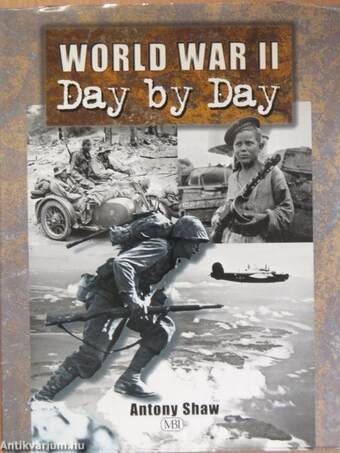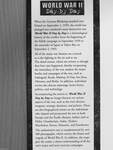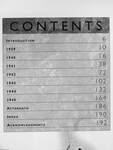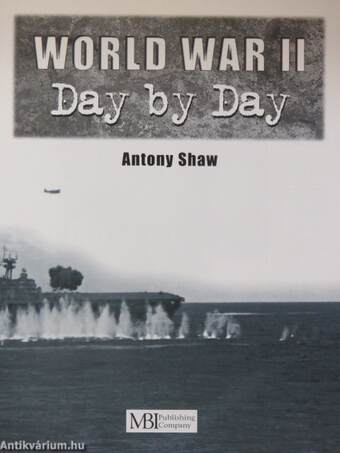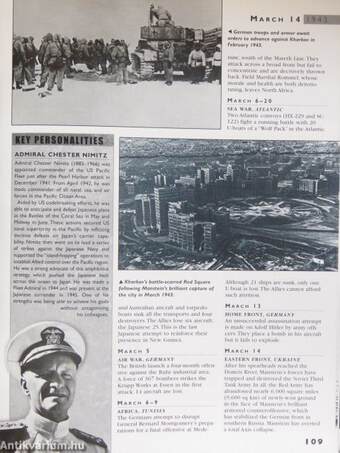1.066.481
kiadvánnyal nyújtjuk Magyarország legnagyobb antikvár könyv-kínálatát

VISSZA
A TETEJÉRE
JAVASLATOKÉszre-
vételek
World War II Day by Day
| Kiadó: | MBI Publishing Company |
|---|---|
| Kiadás helye: | Osceola |
| Kiadás éve: | |
| Kötés típusa: | Fűzött kemény papírkötés |
| Oldalszám: | 191 oldal |
| Sorozatcím: | |
| Kötetszám: | |
| Nyelv: | Angol |
| Méret: | 29 cm x 23 cm |
| ISBN: | 0-7603-0939-6 |
| Megjegyzés: | Fekete-fehér fotókkal, térképekkel. |
naponta értesítjük a beérkező friss
kiadványokról
naponta értesítjük a beérkező friss
kiadványokról
Fülszöveg
WORLD WAR II
Day by Day
When the German Blitzkrieg smashed into
Poland on September 1, 1939, the world was
plunged into mankind's most destructive war.
World War II Day by Day is a chronological
history of the conflict from the beginning of
the Polish campaign in September 1939 to
the surrender of Japan in Tokyo Bay on
September 2, 1945.
All of the major war theaters are covered,
as is the fighting in the air and at sea.
The dated entries, which are written as though
they have just happened, thereby recapturing
the immediacy of the war, analyze the major
battles and campaigns of the war, such as
Stalingrad, Kursk, Midway, D-Day, Iwo Jima,
Okinawa, and Berlin. In addition, individual
entries also discuss espionage, home fronts,
politics, and technology.
Accompanying the entries in World War II
Day by Day are longer features on various
aspects of the war, such as the war's decisive
weapons, strategic decisions, and policies. There
are also biographical... Tovább
Fülszöveg
WORLD WAR II
Day by Day
When the German Blitzkrieg smashed into
Poland on September 1, 1939, the world was
plunged into mankind's most destructive war.
World War II Day by Day is a chronological
history of the conflict from the beginning of
the Polish campaign in September 1939 to
the surrender of Japan in Tokyo Bay on
September 2, 1945.
All of the major war theaters are covered,
as is the fighting in the air and at sea.
The dated entries, which are written as though
they have just happened, thereby recapturing
the immediacy of the war, analyze the major
battles and campaigns of the war, such as
Stalingrad, Kursk, Midway, D-Day, Iwo Jima,
Okinawa, and Berlin. In addition, individual
entries also discuss espionage, home fronts,
politics, and technology.
Accompanying the entries in World War II
Day by Day are longer features on various
aspects of the war, such as the war's decisive
weapons, strategic decisions, and policies. There
are also biographical entries on the individuals
who shaped and prosecuted the war in both
Europe and the Pacific theaters, leaders such as
Hitler, Chamberlain, Stalin, Zhukov,
MacArthur, Patton, Manstein, and Eisenhower.
The authoritative text is complemented by over
400 photographs, which convey the drama and
tragedy of World War II. In addition, the maps
give the reader a clearer understanding of all the
war's major and most intricate campaigns. Vissza
Témakörök
- Idegennyelv > Idegennyelvű könyvek > Angol > Műszaki
- Idegennyelv > Idegennyelvű könyvek > Angol > Történelem > Egyéb
- Történelem > Kézikönyvek > Kronológiák
- Történelem > Idegennyelvű > Angol
- Történelem > Legújabb kor > II. világháború > Hadtörténet
- Történelem > Hadtörténet > Háborúk, csaták
- Történelem > Hadtörténet > Hadtörténeti gyűjtemények, adattárak
- Műszaki > Idegennyelv > Angol
- Műszaki > Hadászat, hadtörténet
Antony Shaw
Antony Shaw műveinek az Antikvarium.hu-n kapható vagy előjegyezhető listáját itt tekintheti meg: Antony Shaw könyvek, művekMegvásárolható példányok
Nincs megvásárolható példány
A könyv összes megrendelhető példánya elfogyott. Ha kívánja, előjegyezheti a könyvet, és amint a könyv egy újabb példánya elérhető lesz, értesítjük.



